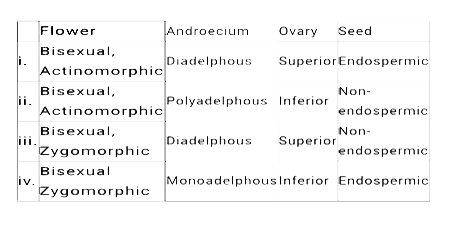Family Fabaceae differs from Solanaceae and Liliaceae.With respect to the stamens,pick out the characteristics specific to family Fabaceae but not found in Solanaceae or Liliaceae.
Polyadelphous and epipetalous stamens
Monoadelphous and Monothecous anthers
Epiphyllous and Dithecous anthers
Diadelphous and Dithecous anthers
Step by step video solution for Family Fabaceae differs from Solanaceae and Liliaceae.With respect to the stamens,pick out the characteristics specific to family Fabaceae but not found in Solanaceae or Liliaceae. by Biology experts to help you in doubts & scoring excellent marks in Class 12 exams.
Updated on:21/07/2023Topper's Solved these Questions
Similar Questions
Knowledge Check
Identify the set of characteristic related to plants belonging to family Fabaceae from the following
AActinomorphic flower, syncarpous ovary and marginal placentationBPersistent calyx, epipetalous stamens and leguminous fruitCPapilionaceous corolla, axile placentation and leguminous fruitDVexillary aestivation of corolla, diadelphous stamens and monocarpellary unilocular ovary.Identify the set of characteristic related to plants belonging to family Fabaceae from the following
APapilionaceous corolla, axile placentation and leguminous fruit.BActionomorphic flower, syncarpous ovary and marginal placentation.CVexillary aestivation of corolla, diadelphous stamens and monocarpellary, unilocular ovary.DPersistent calyx, epipetalous stamens and leguminous fruit.
Choose the option which accurately represents the characteristics of family Fabaceae .

View SolutionEpitepalous conditions is found in (fabaceae/Liliaceae)
View SolutionWhat type of ovary is found in family-Solanaceae ?
View SolutionPersistent calyx is found int eh members of (Solanacea?Liliaceae)
View SolutionDistinguish between families-Fabaceae, Solanaceae, Liliaceae on the basis of gynoecium characteristics (with figures). Also write economic importance of any one of the above family.
View SolutionHow many stamens are present in family Liliaceae?
View Solution
